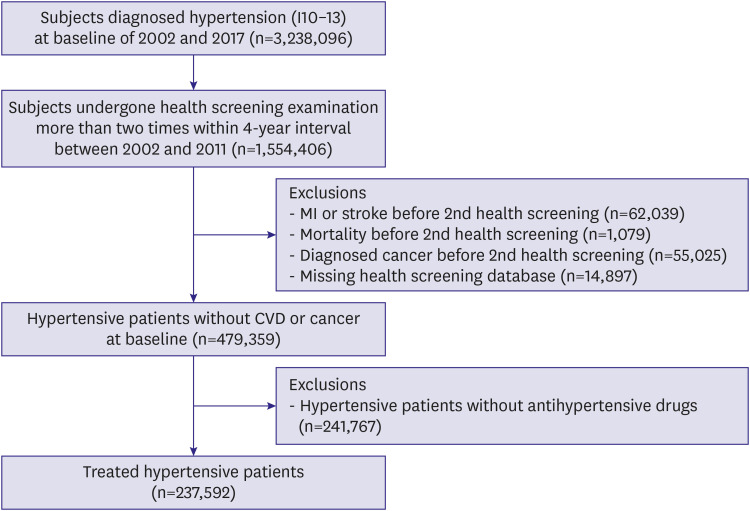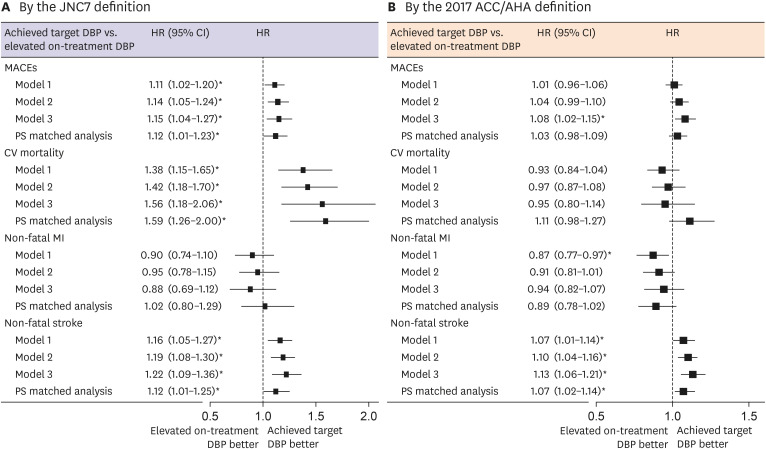Korean Circ J.
2022 Jun;52(6):460-474. 10.4070/kcj.2021.0330.
Elevated On-Treatment Diastolic Blood Pressure and Cardiovascular Outcomes in the Presence of Achieved Systolic Blood Pressure Targets
- Affiliations
-
- 1Division of Cardiology, Asan Medical Center, University of Ulsan College of Medicine, Seoul, Korea
- 2Division of Cardiology, Department of Internal Medicine, Ewha Womans University Seoul Hospital, College of Medicine, Ewha Womans University, Seoul, Korea
- 3Cardiovascular Center, Korea University Guro Hospital, Seoul, Korea
- 4Division of Cardiology, Severance Cardiovascular Hospital and Cardiovascular Research Institute, Yonsei University College of Medicine, Seoul, Korea
- 5Division of Cardiology, Department of Internal Medicine, Hanyang University College of Medicine, Seoul, Korea
- 6Cardiovascular Center, Seoul National University Bundang Hospital, Seoul National University College of Medicine, Seongnam, Korea
- 7Cardiovascular Center, Dongtan Sacred Heart Hospital, Hallym University College of Medicine, Hwaseong, Korea
- 8Division of Cardiology, Department of Internal Medicine, Konkuk University Medical Center, Konkuk University School of Medicine, Seoul, Korea
- 9Division of Cardiology, Department of Internal Medicine, Chungbuk National University Hospital, Chungbuk National University College of Medicine, Cheongju, Korea
- 10Department of Internal Medicine, Seoul Metropolitan Government-Seoul National University Boramae Medical Center, Seoul, Korea
- 11Division of Cardiology, Department of Internal Medicine, Chung-Ang University Hospital, Chung-Ang University College of Medicine, Seoul, Korea
- 12Department of Precision Medicine, Wonju College of Medicine, Yonsei University, Wonju, Korea
- 13Division of Cardiology, Department of Internal Medicine, Seoul National University Hospital, Seoul, Korea
- 14Division of Cardiology, Department of Internal Medicine, Gil Hospital, Gachon University, Incheon, Korea
- 15Department of Internal Medicine, Seoul National University Bundang Hospital, Seoul National University College of Medicine, Seongnam, Korea
- 16Division of Cardiology, Department of Internal Medicine, Yeouido St. Mary’s Hospital, The Catholic University of Korea, Seoul, Korea
- 17Division of Cardiology, Department of Internal Medicine, Kyung Hee University at Gangdong, Seoul, Korea
- 18Division of Cardiology, Department of Internal Medicine, College of Medicine, Hanyang University, Seoul, Korea
- 19Division of Cardiology, Department of Internal Medicine, Eulji Medical School of Medicine, Seoul, Korea
- 20Division of Cardiology, Department of Internal Medicine, Eulji Medical School of Medicine, Seoul, Korea
- 21Department of Biostatistics, Wonju College of Medicine, Yonsei University, Wonju, Korea
- 22Division of Cardiology, Department of Internal Medicine, Bucheon St. Mary’s Hospital, The Catholic University of Korea, Seoul, Korea
- 23Division of Cardiology, Department of Internal Medicine, Kangbuk Samsung Hospital, Sungkyunkwan University School of Medicine, Seoul, Korea
- KMID: 2530455
- DOI: http://doi.org/10.4070/kcj.2021.0330
Abstract
- Background and Objectives
This study aimed to investigate the association between cardiovascular events and 2 different levels of elevated on-treatment diastolic blood pressures (DBP) in the presence of achieved systolic blood pressure targets (SBP).
Methods
A nation-wide population-based cohort study comprised 237,592 patients with hypertension treated. The primary endpoint was a composite of cardiovascular death, myocardial infarction, and stroke. Elevated DBP was defined according to the Seventh Report of Joint National Committee (JNC7; SBP <140 mmHg, DBP ≥90 mmHg) or to the 2017 American College of Cardiology/American Heart Association (ACC/AHA) definitions (SBP <130 mmHg, DBP ≥80 mmHg).
Results
During a median follow-up of 9 years, elevated on-treatment DBP by the JNC7 definition was associated with an increased risk of the occurrence of primary endpoint compared with achieved both SBP and DBP (adjusted hazard ratio [aHR], 1.14; 95% confidence interval [CI], 1.05–1.24) but not in those by the 2017 ACC/AHA definition. Elevated ontreatment DBP by the JNC7 definition was associated with a higher risk of cardiovascular mortality (aHR, 1.42; 95% CI, 1.18–1.70) and stroke (aHR, 1.19; 95% CI, 1.08–1.30). Elevated on-treatment DBP by the 2017 ACC/AHA definition was only associated with stroke (aHR, 1.10; 95% CI, 1.04–1.16). Similar results were seen in the propensity-score-matched cohort.
Conclusion
Elevated on-treatment DBP by the JNC7 definition was associated a high risk of major cardiovascular events, while elevated DBP by the 2017 ACC/AHA definition was only associated with a higher risk of stroke. The result of study can provide evidence of DBP targets in subjects who achieved SBP targets.
Keyword
Figure
Cited by 1 articles
-
On-Treatment Diastolic Blood Pressure: When Is It Too High?
Jin Joo Park
Korean Circ J. 2022;52(6):475-477. doi: 10.4070/kcj.2022.0126.
Reference
-
1. Whelton PK, Carey RM, Aronow WS, et al. 2017 ACC/AHA/AAPA/ABC/ACPM/AGS/APhA/ASH/ASPC/NMA/PCNA guideline for the prevention, detection, evaluation, and management of high blood pressure in adults: Executive summary: a report of the American College of Cardiology/American Heart Association Task Force on Clinical Practice Guidelines. J Am Coll Cardiol. 2018; 71:2199–2269. PMID: 29146533.2. Williams B, Mancia G, Spiering W, et al. 2018 ESC/ESH Guidelines for the management of arterial hypertension. Eur Heart J. 2018; 39:3021–3104. PMID: 30165516.3. Lewington S, Clarke R, Qizilbash N, Peto R, Collins R. Prospective Studies Collaboration. Age-specific relevance of usual blood pressure to vascular mortality: a meta-analysis of individual data for one million adults in 61 prospective studies. Lancet. 2002; 360:1903–1913. PMID: 12493255.
Article4. Yano Y, Reis JP, Tedla YG, et al. Racial differences in associations of blood pressure components in young adulthood with incident cardiovascular disease by middle age: Coronary Artery Risk Development in Young Adults (CARDIA) study. JAMA Cardiol. 2017; 2:381–389. PMID: 28199497.
Article5. Flint AC, Conell C, Ren X, et al. Effect of systolic and diastolic blood pressure on cardiovascular outcomes. N Engl J Med. 2019; 381:243–251. PMID: 31314968.
Article6. Zhang Y, Vittinghoff E, Pletcher MJ, et al. Associations of blood pressure and cholesterol levels during young adulthood with later cardiovascular events. J Am Coll Cardiol. 2019; 74:330–341. PMID: 31319915.
Article7. Thomopoulos C, Parati G, Zanchetti A. Effects of blood pressure lowering on outcome incidence in hypertension: 7. Effects of more vs. less intensive blood pressure lowering and different achieved blood pressure levels - updated overview and meta-analyses of randomized trials. J Hypertens. 2016; 34:613–622. PMID: 26848994.
Article8. Böhm M, Schumacher H, Teo KK, et al. Achieved diastolic blood pressure and pulse pressure at target systolic blood pressure (120-140 mmHg) and cardiovascular outcomes in high-risk patients: results from ONTARGET and TRANSCEND trials. Eur Heart J. 2018; 39:3105–3114. PMID: 29873709.
Article9. Franklin SS. The importance of diastolic blood pressure in predicting cardiovascular risk. J Am Soc Hypertens. 2007; 1:82–93. PMID: 20409835.
Article10. Petrovitch H, Curb JD, Bloom-Marcus E. Isolated systolic hypertension and risk of stroke in Japanese-American men. Stroke. 1995; 26:25–29. PMID: 7839392.
Article11. Strandberg TE, Salomaa VV, Vanhanen HT, Pitkälä K, Miettinen TA. Isolated diastolic hypertension, pulse pressure, and mean arterial pressure as predictors of mortality during a follow-up of up to 32 years. J Hypertens. 2002; 20:399–404. PMID: 11875306.
Article12. Hozawa A, Ohkubo T, Nagai K, et al. Prognosis of isolated systolic and isolated diastolic hypertension as assessed by self-measurement of blood pressure at home: the Ohasama study. Arch Intern Med. 2000; 160:3301–3306. PMID: 11088093.
Article13. Lee H, Yano Y, Cho SM, et al. Cardiovascular risk of isolated systolic or diastolic hypertension in young adults. Circulation. 2020; 141:1778–1786. PMID: 32479205.
Article14. Lee H, Yano Y, Cho SM, Park S, Lloyd-Jones DM, Kim HC. Cardiovascular risk of isolated diastolic hypertension defined by the 2017 American College of Cardiology/American Heart Association blood pressure guideline: a nationwide age-stratified cohort study. Hypertension. 2020; 76:e44–e46. PMID: 33070661.
Article15. McEvoy JW, Daya N, Rahman F, et al. Association of isolated diastolic hypertension as defined by the 2017 ACC/AHA blood pressure guideline with incident cardiovascular outcomes. JAMA. 2020; 323:329–338. PMID: 31990314.
Article16. Cheol Seong S, Kim YY, Khang YH, et al. Data Resource Profile: The National Health Information Database of the National Health Insurance Service in South Korea. Int J Epidemiol. 2017; 46:799–800. PMID: 27794523.
Article17. Seong SC, Kim YY, Park SK, et al. Cohort profile: the National Health Insurance Service-National Health Screening Cohort (NHIS-HEALS) in Korea. BMJ Open. 2017; 7:e016640.
Article18. Quan H, Li B, Couris CM, et al. Updating and validating the Charlson comorbidity index and score for risk adjustment in hospital discharge abstracts using data from 6 countries. Am J Epidemiol. 2011; 173:676–682. PMID: 21330339.
Article19. Park TH, Choi JC. Validation of stroke and thrombolytic therapy in Korean National Health Insurance claim data. J Clin Neurol. 2016; 12:42–48. PMID: 26365022.
Article20. Bangalore S, Guo Y, Samadashvili Z, Blecker S, Xu J, Hannan EL. Everolimus-eluting stents or bypass surgery for multivessel coronary disease. N Engl J Med. 2015; 372:1213–1222. PMID: 25775087.
Article21. Mancia G. Blood pressure reduction and cardiovascular outcomes: past, present, and future. Am J Cardiol. 2007; 100:3J–9J.
Article22. Muntner P, Whelton PK. Using predicted cardiovascular disease risk in conjunction with blood pressure to guide antihypertensive medication treatment. J Am Coll Cardiol. 2017; 69:2446–2456. PMID: 28494981.
Article23. Yano Y, Stamler J, Garside DB, et al. Isolated systolic hypertension in young and middle-aged adults and 31-year risk for cardiovascular mortality: the Chicago Heart Association Detection Project in Industry study. J Am Coll Cardiol. 2015; 65:327–335. PMID: 25634830.
Article24. Choi YJ, Kim SH, Kang SH, et al. Reconsidering the cut-off diastolic blood pressure for predicting cardiovascular events: a nationwide population-based study from Korea. Eur Heart J. 2019; 40:724–731. PMID: 30535368.
Article25. Kannel WB, Gordon T, Schwartz MJ. Systolic versus diastolic blood pressure and risk of coronary heart disease. The Framingham study. Am J Cardiol. 1971; 27:335–346. PMID: 5572576.
Article26. Franklin SS, Larson MG, Khan SA, et al. Does the relation of blood pressure to coronary heart disease risk change with aging? The Framingham Heart Study. Circulation. 2001; 103:1245–1249. PMID: 11238268.
Article27. Fang J, Madhavan S, Cohen H, Alderman MH. Isolated diastolic hypertension. A favorable finding among young and middle-aged hypertensive subjects. Hypertension. 1995; 26:377–382. PMID: 7649569.28. Blank SG, Mann SJ, James GD, West JE, Pickering TG. Isolated elevation of diastolic blood pressure. Real or artifactual? Hypertension. 1995; 26:383–389. PMID: 7649570.




